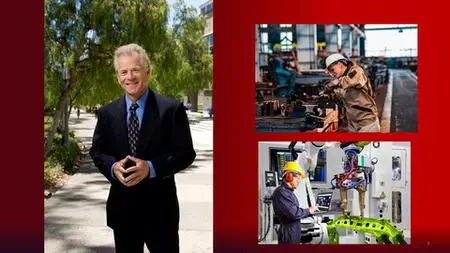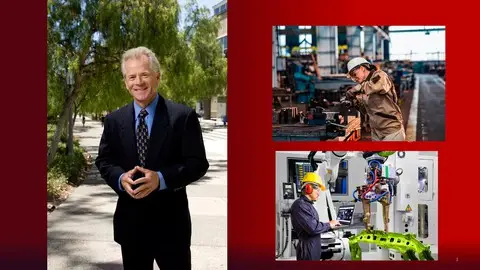Microeconomics Principles For A Prosperous Life
Published 1/2023
MP4 | Video: h264, 1280x720 | Audio: AAC, 44.1 KHz
Language: English | Size: 11.70 GB | Duration: 10h 6m
Published 1/2023
MP4 | Video: h264, 1280x720 | Audio: AAC, 44.1 KHz
Language: English | Size: 11.70 GB | Duration: 10h 6m
Mastering and Harnessing the Power of Microeconomics
What you'll learn
Learn the basic principles of microeconomics from a strategic point of view
Learn how to apply microeconomics in your daily personal and business life
Better manage your personal finances and economic choices
Better manage your workplace, whether you are an executive, manager, or line worker
Requirements
This course is freshman level college and above but available to all advanced high schools students as well
Description
In this course, you will learn all of the major principles of microeconomics normally taught in a quarter or semester course to college undergraduates or MBA students.Perhaps more importantly, you will also learn how to apply these principles to a wide variety of real-world situations in both your personal and professional lives. In this way, a mastery of Microeconomic Principles will help you prosper in an increasingly competitive environment.Topics include supply and demand, strategic marketing and microeconomics, consumer and production theory, an overview of operations and supply chain management, perfect competition, oligopoly, monopoly, strategic capital finance, how wages and rents are set, the importance of organizational culture and behavior, public goods, and the externalities problem.Key concepts include the production possibilities frontier, opportunity costs, the law of demand, price floors and ceilings, marginal utility, price elasticity, economies of scale and natural Monopoly, the structure-conduct-performance paradigm, Pareto optimality, deadweight loss, efficiency versus equity, product differentiation, tacit versus explicit collusion, net present value, factors affecting wage differentials, rent versus economic rent, the free rider problem, negative versus positive externalities, Pigouvian taxes and subsidies, the median voter model, and progressive versus regressive taxes.Note that this course is a companion to Strategic Macroeconomics for Business and Investing. If you take both courses, you will learn all of the major principles normally taught in a year-long introductory economics college course.
Overview
Section 1: Introduction to Strategic Microeconomics for Business & Investing
Lecture 1 Module 1.1: An Introduction to Strategic Microeconomics
Lecture 2 Module 1.2: Microeconomics in Our Everyday Business & Personal Lives
Lecture 3 Module 1.3: Microeconomics Defined and Major Economic Models
Lecture 4 Module 1.4: The Scarcity Problem; & Three Questions Every Nation Must Answer
Lecture 5 Module 1.5: The Production Possibilities Frontier & Opportunity Costs
Lecture 6 Module 1.6: The Fundamental Concepts of Microeconomics & Course Overview
Section 2: Supply and Demand
Lecture 7 Module 2.1: Law of Demand, Income-Substitution Effects, Demand Curve Shifts
Lecture 8 Module 2.2: Change in Demand vs. Change in Quantity Demanded; Supply Shifts
Lecture 9 Module 2.3: Equilibrium; Price Effects of Supply and Demand Curve Shifts
Lecture 10 Module 2.4: Price Floors, Price Ceilings, and Rationing
Lecture 11 Module 2.5: Supply & Demand Analysis in Business Action
Section 3: An Introduction to Consumer Theory
Lecture 12 Module 3.1: From Consumer Theory to Strategic Marketing
Lecture 0 Module 3.2: Consumer Optimization; Income and Substitution Effects
Lecture 13 Module 3.3: Demand Price Elasticity; Price Elasticity Formula
Lecture 0 Module 3.4: Demand Price Elasticity Determinants; Elastic and Inelastic Demand
Lecture 0 Module 3.5: Pricing and Marketing Strategies; Price Elasticity and Total Revenue
Lecture 14 Module 3.6: Strategic Marketing and Microeconomics
Lecture 0 Module 4.1: Overview of Production Theory and the Production Function
Lecture 0 Module 4.2: Average, Marginal, Variable, and Total Costs
Lecture 0 Module 4.3: Marginal Cost; The AFC, ATC, and AVC Curves
Lecture 0 Module 4.4: Long Run Cost Analysis and Economies of Scale
Lecture 0 Module 4.5: The Structure-Conduct-Performance Paradigm and Natural Monopoly
Lecture 0 Module 4.6: Accounting vs. Economic Profits
Lecture 0 Module 4.7: Operations and Supply Chain Management
Lecture 0 Module 5.1: Overview of Industry Structure, Conduct, and Performance
Lecture 0 Module 5.2: Assumptions of Perfect Competition; The P=MR Condition
Lecture 0 Module 5.3: Imperfect Competition; Externalities and the Public Goods Problem
Lecture 0 Module 5.4: Pricing and Production Rules; P=MR=MC; The Shutdown Rule
Lecture 0 Module 5.5: Long Run Equilibrium; Normal or Zero Economic Profits
Lecture 0 Module 5.6: Allocative vs. Productive Efficiency; Pareto Optimality; Surplus
Lecture 0 Module 5.7: Efficiency vs. Equity; Normative vs. Positive Analysis
Lecture 0 Module 6.1: Why Study Imperfect Competition?
Lecture 0 Module 6.2: Monopoly Defined and Monopoly's Pricing Rule
Lecture 0 Module 6.3: Regulating Natural Monopoly; The P=AC Rule; X-efficiency
Lecture 0 Module 6.4: Monopolistic Competition; Product Differentiation
Lecture 0 Module 6.5: Market Conduct Under Monopolistic Competition
Lecture 0 Module 6.6: An Introduction to Management Strategy
Lecture 0 Module 7.1: Oligopoly Defined; Strategic Interactions and Mutual Dependence
Lecture 0 Module 7.2: Major Sources of Oligopoly
Lecture 0 Module 7.3: Market Power and Action; Cooperative vs. Non-Cooperative Behavior
Lecture 0 Module 7.4: Joint Profit Maximization Model; Why Cartels Can Fail; Price Leaders
Lecture 0 Module 7.5: Joint Profit Max Model; Why Cartels Can Fail; Price Leadership Model
Lecture 0 Module 7.6: Game Theory and Prisoner’s Dilemma; Payoff Matrix; Nash Equilibrium
Lecture 0 Module 8.1: Capital Analysis in Real World; Big Questions of Corporate Finance
Lecture 0 Module 8.2: Capital Goods; Interest Rate Defined; Rate of Return
Lecture 0 Module 8.3: Depreciation; Theory of Loanable Funds; Two Interest Rate Functions
Lecture 0 Module 8.4: Net Present Value; Perpetuities; Demand, Supply and Interest Rates
Lecture 0 Module 8.5: NPV In the Real World; The NPV Equation
Lecture 0 Module 8.6: Interest Rates In Real World; Factors Determining Interest Rates
Lecture 0 Module 8.7: The Capital Asset Pricing Model
Lecture 0 Module 9.1: Key Concepts of Organizational Behavior
Lecture 0 Module 9.2: The Wage Rate, Unions, and Monopsony
Lecture 0 Module 9.3: Derived Demand for Labor; Theory of Resource Demand
Lecture 0 Module 9.4: Wages, Productivity, and Product Prices; Backward Bending Curve
Lecture 0 Module 9.5: Wages in Imperfectly Competitive Labor Markets; Monopsony & Monopoly
Lecture 0 Module 9.6: Wage and Compensating Differentials; Quasi-rents; Human Capital
Lecture 0 Module 9.7: How Land is Priced; Rent Versus Economic Rent
Lecture 0 Module 9.8: The "Corn Wars" and Theory of Ricardian Rents; Property Rights
Lecture 0 Module 9.9: Henry George’s Land Tax; Tax Incidence Analysis
Lecture 0 Module 9.10: Determinants of the Price of Land and Rents; Rent Seeking
Lecture 0 Module 10.1: The Logic of Government Intervention
Lecture 0 Module 10.2: Public vs. Private Goods; Non-rival Consumption; Free Rider Problem
Lecture 0 Module 10.3: Economic Efficiency & Public Goods; Market Demand for Public Goods
Lecture 0 Module 10.4: Benefit-Cost Analysis and the Decision Rule
Lecture 0 Module 10.5: Negative and Positive Externalities
Lecture 0 Module 10.6: Correcting Market Failures; The Coase Theorem; Pigouvian Taxes
Lecture 0 10.7: Government Intervention; Pigouvian Taxes; Internalizing Externalities
Lecture 0 Module 10.8: Progressive, Proportional, and Regressive Taxes
Lecture 0 Module 10.9: Public Choice; The Median Voter Model; The Paradox of Voting
nvestors, corporate executives, and just plain folks interested in managing their finances, workplace, and economic choices in an increasingly chaotic global economic environment



